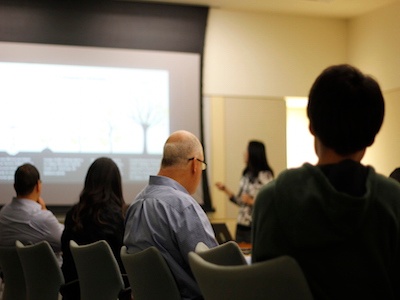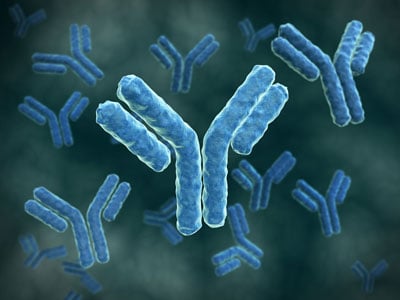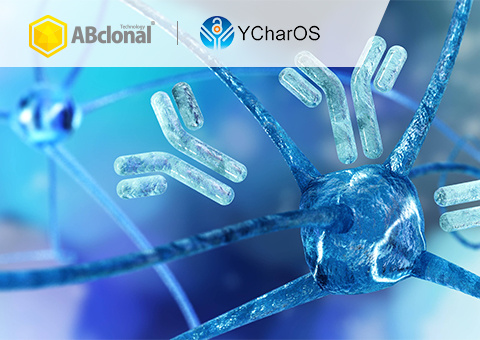 I recall having to make hundreds of custom peptides, and even though we used an automated peptide synthesizer rather than doing it by hand like another lab in the building, making a dozen peptides at a time still took hours on the machine and then another couple days for the purification and lyophilization processes. My mentor and I briefly joked about using bacteria and a polycistronic construct to just have the little guys use their ribosomes to do it for us, but the purification process probably would have been impractical. This does make me appreciate the wonders of natural biosynthetic machinery, and I promise there is a point here because we still use animal hosts to initially produce antibodies. Today, let's explore the process by which most commercial and custom antibodies are still produced, including here at ABclonal!
I recall having to make hundreds of custom peptides, and even though we used an automated peptide synthesizer rather than doing it by hand like another lab in the building, making a dozen peptides at a time still took hours on the machine and then another couple days for the purification and lyophilization processes. My mentor and I briefly joked about using bacteria and a polycistronic construct to just have the little guys use their ribosomes to do it for us, but the purification process probably would have been impractical. This does make me appreciate the wonders of natural biosynthetic machinery, and I promise there is a point here because we still use animal hosts to initially produce antibodies. Today, let's explore the process by which most commercial and custom antibodies are still produced, including here at ABclonal!
Natural Recombination to Generate Antibody Diversity
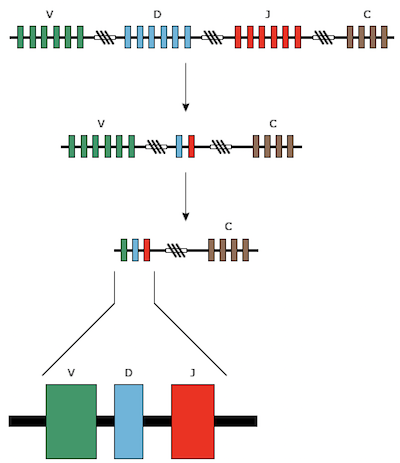 As this Kurzgesagt video shows, the mammalian adaptive immune system is one of the most amazing innovations ever made by evolution, with the ability to recognize even antigens the animal hasn't even encountered yet. The video doesn't go into extreme detail, but does allude to the official explanation, which is now known as V(D)J recombination, a process discovered by Susumu Tonegawa and earned him the Nobel Prize. Antibody production takes advantage of the ability of the B cells in the organism (as well as T cells) to rearrange DNA modules to form the heavy and light chains of the antibody, combining the fragments in a specific manner that generates new complementarity-determining regions (CDR) at the junctions of these modules through random chance to build the ultimate library against potential invading pathogens. The diagram to the right illustrates a simplified version of V(D)J recombination under the activity of a dedicated recombinase, although in reality, most mammals will have dozens or hundreds of the V fragments and a varying number of D and J fragments to recombine into a functional antibody that recognizes a foreign antigen.
As this Kurzgesagt video shows, the mammalian adaptive immune system is one of the most amazing innovations ever made by evolution, with the ability to recognize even antigens the animal hasn't even encountered yet. The video doesn't go into extreme detail, but does allude to the official explanation, which is now known as V(D)J recombination, a process discovered by Susumu Tonegawa and earned him the Nobel Prize. Antibody production takes advantage of the ability of the B cells in the organism (as well as T cells) to rearrange DNA modules to form the heavy and light chains of the antibody, combining the fragments in a specific manner that generates new complementarity-determining regions (CDR) at the junctions of these modules through random chance to build the ultimate library against potential invading pathogens. The diagram to the right illustrates a simplified version of V(D)J recombination under the activity of a dedicated recombinase, although in reality, most mammals will have dozens or hundreds of the V fragments and a varying number of D and J fragments to recombine into a functional antibody that recognizes a foreign antigen.
Just like bacterial ribosomes in our introductory example, the host animal's adaptive immune system is the best tool in creating the ideal antibody reagent from scratch. Although there are programs that can help predict antigen binding performance and allow scientists to potentially build an antibody from the ground up using molecular biology and genetic engineering, it remains the most efficient method to just let the laboratory animal do it, be it a mouse, a rabbit, or even an alpaca. Once the animal has been boosted through multiple rounds of immunization to enrich for the target-specific antibody pool, that pool can be purified and subcloned, and subsequently re-engineered to produce a perpetual supply of recombinant antibodies with minimal batch inconsistencies going forward. The antibody can even be adjusted further for better binding affinity, humanization, or other applications. Penny wrote a blog about the various methods of generating rabbit monoclonal antibodies once upon a time that will give you an idea of how these important research reagents are produced and validated for the best affinity and specificity in experimental workflows. But this does explain why most antibody production workflows always start with using an animal, and we take great care to ensure the best welfare for our animals.
Being a Gracious Host: Choosing the Best Animal For the Job!
ABclonal's services include antigen design, and the antigen can inoculate any mammalian species that is desired, although most of the time, scientists will choose either rabbit or mouse as those are the most common hosts recognized by secondary antibodies as well as the most convenient hosts to house in most facilities. There is also a blog about why you would choose rabbit or mouse, but the gist is that the choice of host depends very much on your experimental goal. ABclonal will encourage you to choose rabbit due to their larger antibody diversity and the higher titers available from each immunized animal, but we can consider some quick examples here:
- If you're looking for a fast, cost-effective reagent in a pilot study, a mouse antibody will likely accommodate most of these early applications.
- If you need a more specific antibody, a rabbit, with more V, D, and J modules to choose from in their genome, will be able to produce a more robust repertoire of antibodies that are likely better at recognizing your desired antigen, and can be better at identifying post-translational modifications and minute changes (like point mutations) in a target.
- If you need a specialized reagent such as a nanobody, a camelid species such as camel (obviously!) or an alpaca can be used to generate VHH antibodies that can be engineered into a nanobody.
Of course, with antibody engineering and expression services, once we have the proper antigen-recognition sequence from the originally produced antibody, ABclonal can work with you to improve binding efficiency, and even swap out the antibody constant region or re-engineer to another host (including human) and tailor it to your exact application!
BioChat: Working in ABclonal's Custom Antibody Services
On this episode of BioChat, I hang out with Rosa Zhu, our technical support scientist for the Custom Antibody Services, to talk about how antibodies are generated and how ABclonal can help you develop the optimal reagent for your experiments. Rosa immigrated from China to obtain her PhD in the United States after being heavily influenced by her scientist parents, and now lives in Chicago, which I'm immensely jealous of.
In this episode, Rosa and I talk about:
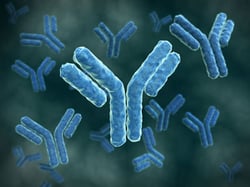 Rosa's inspiration to become a scientist;
Rosa's inspiration to become a scientist;- The many factors that go behind antigen design for particular applications;
- Advantages of using polyclonal antibodies versus monoclonal antibodies;
- Improvements in the traditional hybridoma methodology and subsequent modifications;
- ABclonal's and our clients' spirit of collaboration
If you are interested in setting up your own custom antibody reagents, which include the personalized packages described by Rosa in this episode, or just want to learn more about our process, please feel free to reach out to us at service@abclonal.com or check out our service page and we would be happy to work with you!
SMab™: Single Primary B Cell Ex Vivo Expansion
We also have a new episode of BioChat where we are joined by Dr. Hai Wu, chief technology officer at ABclonal, to discuss our innovative SMab™ technology that has been used to generate thousands of new custom monoclonal antibodies for industry and academic research. Listen below and stay tuned for more advances from ABclonal's antibody development pipeline!
Please check out our BioChat page to learn how to subscribe (and of course please rate and review us on Apple Podcasts!) and check out our latest episode by clicking the player above. Thanks for listening!


